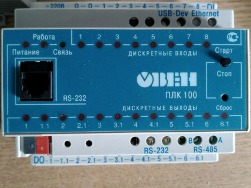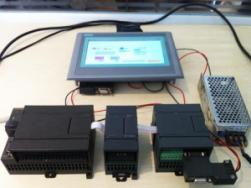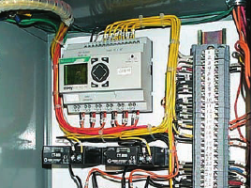Examples of simple PLC programs in CodeSys in ladder language
 This article shows an example of three simple programs for programmable logic controllers (PLCs). All programs are written to automate control systems for various installations in the industry. They are educational in nature and can be used to teach PLC programming. Earlier on this topic, we examined several typical solutions in PLC programs that can be used to control electric motors.
This article shows an example of three simple programs for programmable logic controllers (PLCs). All programs are written to automate control systems for various installations in the industry. They are educational in nature and can be used to teach PLC programming. Earlier on this topic, we examined several typical solutions in PLC programs that can be used to control electric motors.
This collection covers automation of the following processes: an automatic system for discarding bottles, automatic pigment color selection, and automation of a ventilation system. All programs are written inCodeysin the language of ladder diagrams. In the first installationa conveyor belt is used to move bottles from one station to another. But before the bottles get to the gas station, it is necessary to make all the bottles worthwhile for further filling. A falling bottle on a conveyor can create a problem ...
Motor starting diagrams in the ladder diagram language LD for PLC
 With this article, we begin a series of training materials for creating programs for programmable logic controllers (PLCs) in the CodeSys environment. It is best to learn how to program PLCs using real-life practical examples.
With this article, we begin a series of training materials for creating programs for programmable logic controllers (PLCs) in the CodeSys environment. It is best to learn how to program PLCs using real-life practical examples.
Consider a few simple programs that you can use to control squirrel cage induction motors. To create the programs, we will use the LD ladder diagram language in CodeSys. Ladder Diagram Language, LD) in the Russian-language documentation for the PLC is often called the language of relay-contact circuits (RCS). This graphic language was created in the 70s. XX century and first of all it was created for electricians, who at that time had to upgrade relay-contact circuits with discrete devices (relays, timers, counters, etc.) into circuits using PLCs. He has been a leader in popularity for a long time ...
 In the reviews of the previous article on this topic, there was a desire to make material with a more detailed step-by-step analysis of the process of writing a program in CFC inCoDeSys. Since it’s not very interesting to reassemble the circuit from the previous article, this time let's take something else as an example, for example, the once very popular pump station with pumping pumps.
In the reviews of the previous article on this topic, there was a desire to make material with a more detailed step-by-step analysis of the process of writing a program in CFC inCoDeSys. Since it’s not very interesting to reassemble the circuit from the previous article, this time let's take something else as an example, for example, the once very popular pump station with pumping pumps.
So, there is a drainage type pumping station with two pumps. Water rushes into the reservoir by gravity, and the task of the pumps is to pump it out of this reservoir, in order to prevent its overfilling. One of the pumps according to the scheme is the main, the second is the backup. The scheme provides for the possibility of assigning a primary and backup pump using a switch. Initially, the pump is turned on, which is designated as the main one, and if it cannot cope with pumping out the liquid, then the standby pump is automatically turned on to its aid ...
 Recently, the topic of automation of various technological processes using programmable controllers (PLCs) has become increasingly popular. Despite this, there are very few practical articles on the Internet with real examples of how to program these PLCs. This topic is very interesting. Learning how to write PLC programs is possible even without them. The emulation mode, which is available in all modern software packages, helps a lot with this.
Recently, the topic of automation of various technological processes using programmable controllers (PLCs) has become increasingly popular. Despite this, there are very few practical articles on the Internet with real examples of how to program these PLCs. This topic is very interesting. Learning how to write PLC programs is possible even without them. The emulation mode, which is available in all modern software packages, helps a lot with this.
In this article I will show an example of translating an electrical circuit built on relay devices (starters, relays) into a program that will work on the controller. I must say right away that this is just a small educational project and does not pretend to explain anything more than just explaining the basic principles of PLC programming with a concrete example. The initial scheme for this project is a relatively simple scheme of a two-story linkage truck hoist ...
Functional Block Diagram Language (FBD) and its Application
 One of the most popular programming languages of PLCs - programmable logic controllers, is the graphic language of functional block diagrams FBD - Function Block Diagram. This language, along with other languages of the IEC 61131-3 standard, such as for example the ladder logic (LD) language, uses in its architecture a kind of electronic circuit.
One of the most popular programming languages of PLCs - programmable logic controllers, is the graphic language of functional block diagrams FBD - Function Block Diagram. This language, along with other languages of the IEC 61131-3 standard, such as for example the ladder logic (LD) language, uses in its architecture a kind of electronic circuit.
A program written in this language for a controller consists of a certain list of circuits that are executed one after the other from top to bottom. In addition, there is the possibility of assigning labels to individual chains, in this case, the use of instructions to go to the label will be available in order to change the sequence of execution of chains, and create conditions and cycles. Thus, a program written in the graphic language FBD is a set of functional blocks connected to each other, the outputs and inputs of which are connected by communication lines ...
LD Ladder Language and its Application
 The ladder or ladder diagram language LD (from the English Ladder Diagram) is an easy-to-use, graphical development language. It is based on relay-contact circuits, so the logic elements here are: relay windings, relay contacts, horizontal and vertical jumpers.
The ladder or ladder diagram language LD (from the English Ladder Diagram) is an easy-to-use, graphical development language. It is based on relay-contact circuits, so the logic elements here are: relay windings, relay contacts, horizontal and vertical jumpers.
A pair of relay contacts or buttons are the main logical variables of the LD language, while the state of the variables is nothing more than the state of the contacts: open or closed. The program itself in this graphic language seems to be an analogue of the relay circuit, which can include many different functional blocks. In general, the syntax of the LD language makes it very easy to build logic circuits for relay technology. As such, the language of relay circuits existed in the time of Thomas Edison, and only in the early 1970s it was adapted for the first PLCs ...

A significant part of the organization’s costs in the field of housing and communal services are electricity costs. Let's look at an example of how you can organize one of the measures to save electricity by automating lighting control in classrooms.
Modern lighting control systems allow you to create optimal conditions for the stay, the presence of people, as well as significantly save energy. A very common situation - students and teachers, having spent a lesson in the classroom, constantly forget to turn off the lights after leaving. This raises the problem - how to make sure that after the last person leaves the classroom, the light turns off itself? The aim of our work was to create a computer model of an automated lighting control system in the classroom, which saves energy. An automatic was designed ...
Using ARIES PLC in automatic lighting control systems
 Home automation often starts with the simple, urgent task of controlling lighting. It is often necessary to control the on and off light from different places or from a common remote control or a set of buttons. Moreover, the number of lighting fixtures, rooms, switches is always different. And the control scheme is different from task to task.
Home automation often starts with the simple, urgent task of controlling lighting. It is often necessary to control the on and off light from different places or from a common remote control or a set of buttons. Moreover, the number of lighting fixtures, rooms, switches is always different. And the control scheme is different from task to task.
In this material we will consider a universal tool for solving such a problem - a freely programmable controller Aries PLC. With this device, you can automate the lighting of almost any complexity. At the same time, intermediate contacts are not needed, switching of electric circuits occurs using built-in electromagnetic relays. The creation of the work algorithm begins with the download of the CoDeSys program. It is free and is included in the scope of delivery of the PLC ...
